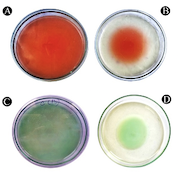Biosurfactant derived from probiotic Lactobacillus acidophilus exhibits broad-spectrum antibiofilm activity and inhibits the quorum sensing-regulated virulence
DOI:
https://doi.org/10.17305/bb.2023.9324Keywords:
Biosurfactant, Lactobacillus acidophilus, antibiofilm, quorum sensing (QS), virulenceAbstract
Antimicrobial resistance by pathogenic bacteria has become a global risk to human health in recent years. The most promising approach to combating antimicrobial resistance is to target virulent traits of bacteria. In the present study, a biosurfactant derived from the probiotic strain Lactobacillus acidophilus was tested against three Gram-negative bacteria to evaluate its inhibitory potential on their biofilms, and whether it affected the virulence factors controlled by quorum sensing (QS). A reduction in the virulence factors of Chromobacterium violaceum (violacein production), Serratia marcescens (prodigiosin production) and Pseudomonas aeruginosa (pyocyanin, total protease, LasB elastase and LasA protease production) was observed at different sub-MIC concentrations in a dose-dependent manner. Biofilm development was reduced by 65.76%, 70.64% and 58.12% at the highest sub-MIC levels for C. violaceum, P. aeruginosa and S. marcescens, respectively. Biofilm formation on glass surfaces exhibited significant reduction, with less bacterial aggregation and reduced formation of extracellular polymeric materials. Additionally, swimming motility and exopolysaccharides (EPS) production were shown to be reduced in the presence of the L. acidophilus-derived biosurfactant. Furthermore, molecular docking analysis performed on compounds identified through gas chromatography–mass spectrometry (GC-MS) analysis of QS and biofilm proteins yielded further insights into the mechanism underlying the anti-QS activity. Therefore, the present study has clearly demonstrated that a biosurfactant derived from L. acidophilus can significantly inhibit virulence factors of Gram-negative pathogenic bacteria. This could provide an effective method to inhibit the formation of biofilms and QS in Gram-negative bacteria.
Citations
Downloads

Downloads
Additional Files
Published
Issue
Section
Categories
License
Copyright (c) 2023 Mohd Adnan, Arif Jamal Siddiqui, Emira Noumi, Syed Amir Ashraf, Amir Mahgoub Awadelkareem, Sibte Hadi, Mejdi Snoussi, Riadh Badraoui, Fevzi Bardakci, Manojkumar Sachidanandan, Mitesh Patel

This work is licensed under a Creative Commons Attribution 4.0 International License.
How to Cite
Accepted 2023-06-30
Published 2023-11-03









